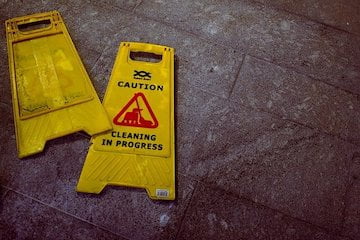HOW TO MANAGE HEALTH & SAFETY
In this article, How to Manage Health and Safety we cover:- Why managing health and safety is important
- What is health and safety management?
- Health and safety policy
- Health and Safety Procedures
- Risk Management
- Risk Assessment
- What are Hazards and Risks?
- Health and safety meetings
- Role of the health and safety committee
- Health and safety inspections
Why is managing health and safety is important?
Health and Safety Management is achieving a workplace free from unacceptable risks of harm.While we’re considered how to manage health and safety. Let’s first quickly think about Why we should manage health and safety? This will help you understand the level of resources required.There are three why you need to manage safety. These are:Moral – People are killed at work each year. It stands to reason employer should provide safe workplaces.Legal – Safe workplaces are a legal requirement of the Health & Safety Act 1974Financial – Accidents, injury, and work-related ill cost the UK over £20 billion annually. A safe workplace reduces the number of sickness days and damaged equipment.Here we have a more extensive article covering why manage health and safetyHow to manage health and safety
It requires a structured and systematic approach.Successful Health and Safety Management within any organisation must stem from the demonstrated and actual commitment, with acceptance of responsibility, of the people at the top of the organisation and down through a clear chain of command.For the Management of Health and Safety to be successful, the Management Team, starting from the top of the organisation, must be involved. It is their responsibility to:- Develop a clear vision and set demanding goals and targets
- Introduce a Health and Safety Plan
- Monitor implementation of the Health and Safety Plan
- Organising
- Planning and Implementing
- Measuring Performance
- Reviewing Performance
- Auditing
- Feedback loop to improve continually reduce risks
Health and Safety Policy
Once top management is engaged and a plan in place its time to write a health & safety policy.The Health and Safety Policy is the top level document within an organisation that sets out the direction and framework for managing Health and Safety. The policy also describes the beliefs and principles that we want to aspire to.It is important to understand the need for Health and Safety Policy Statement. The Health and Safety Policy is your starting out point to managing Health and Safety in the workplace. By law, if you employ five or more people, you must have written Health and Safety Policy.The policy should contain a signed and dated commitment from either the Chief Executive of Managing Director to achieve the highest standards of Health and Safety Management and a safe place of work.The policy should describe the responsibilities key persons have for Health and Safety Management, e.g. who will carry out Risk Assessments, who will be responsible for the maintenance of equipment, who will co-ordinate emergency procedures and who will ensure the safe handling and use of substances.To ensure the Health and Safety Policy is effectively implemented, it must be communicated to all employees throughout the organisation and made available to contractors and visitors.Health and Safety Procedures
Next its time to create specific safety procedures.Procedures help ensure activities and tasks are carried out in a consistent and safe manner. If these procedures are not valued and understood, there could be a higher chance of an accident or ill health.Managers should ensure that:- All key tasks and activities are covered by a procedure
- The procedures are understood and followed employees, visitors and contractors
- Data analysis
- Proof of work being carried out
- Evidence in case of criminal or civil actions
Risk Management
Fundamentally health and safety management is about reducing the risks of accidents and ill health in the workplace to an ‘appropriate level’. Risk Management means being responsible for managing the risk to the organisation, its employees, customers, reputation and the assets and interests of stakeholders. Good Risk Management will identify any threats or potential risks for the company, put plans in place for if things go wrong and decide how to avoid, reduce and transfer risks.Risk Management can be defined as: ‘The minimisation of the adverse effects of pure and speculative risks within an organisation.’Risk Management is a process that involves assessing the risks that arise in your workplace, putting sensible Health and Safety measures in place to control them and then making sure they work in practice. This process is known as a Risk Assessment.Sensible Risk Management is about:● Ensuring the safety of the workers and the public ● Providing overall benefit to society by balancing benefits and risks, with a focus on reducing real risks that arise frequently and/or have serious consequences ● Enabling innovation and learning and not stifling it ● Ensuring that those who create risks manage them responsibly and understand that failure to manage real risks is likely to lead to robust action ● Enabling individuals to understand that along with the right to protection, they also have responsibilities towards managing risks they createSensible Risk Management is NOT about:
● Creating a totally risk free society ● Generating useless paperwork mountains ● Scaring people by exaggerating or publicising trivial risks ● Stopping important recreational and learning activities for individuals where the risks are managed ● Reducing protection of people from risks that cause real harm and sufferingRisk Assessment
Risk Assessment is a legal requirement.“Every employer shall make a suitable and sufficient assessment of the risks to the Health and Safety of his employees to which they are exposed whilst they are at work.” UK Managing Health & Safety Regulations 1999.We have a more details article on What Risk Assessments are.The dictionary defines Risk Assessment as: “The act of appraising or valuing the nature, character, quality, status or worth of something”.Aim of Risk Assessment – Although the appraisal or evaluation element is a key part of the Risk Assessment process, this only goes part way towards explain assessment as a management tool. The aim of Risk Assessment is to prevent loss, whether due to personal injury or property damage, from occurring.Objective of Risk Assessment – The objective is to identify all the factors which may cause harm to employees and others, and to consider the chance or likelihood of that harm actually befalling anyone in the circumstances of a particular case.The possible consequences that could come from it enable employers to plan, introduce and monitor measures to ensure that the risks are adequately eliminated or controlled at all times.Health & Safety Meetings
Communicating the organisation’s vision, goals and targets to all persons within the organisation helps them understand their role and contribution expected from them. This in turn enables these visions, goals and targets to be successfully achieved.One way of communicating this is through written responsibilities.Health and Safety Meetings:● Are a forum where findings from many types of workplace monitoring can be discussed, reviewed and acted upon ● Should be a formal part of the Management systemThere should be a formally constituted safety committee for making and carrying out the safety plan or organisation objectivesThe Safety Committee
The Safety Committee:● Should represent employees and management ● Members should represent a good cross-section of the workforce ● Members should have sufficient opportunity to consult with other employees prior to the meetingA management steering group should also be in place that supports the safety committee and links into the safety plan/organisation’s objectives.The Safety Committee Meetings:● The members of the safety committee should meet on a regular basis ● The meetings should have a structured agenda, issued in advance ● Minutes of all meetings should be taken and made available to all employees ● The minutes of meetings should include responsibilities and timescales for actionManagers should ensure that regular Health and Safety workplace inspections are carried out. Managers should be part of the team that carries out the inspections.Health and Safety Inspections
Health and Safety Inspections:● These inspections are a means of taking a snapshot of the conditions in the workplace ● These inspections should be completed relatively quickly, possibly 1 to 2 hours maximum ● These inspections should be structured and carried out regularly ● The inspection team should use a checklist as an aid whilst touring the workplace ● Findings from the inspections should be recorded and actions followed through to completion ● There should be an effective method of tracking the status actionsMeasurement is a key step in any management process and forms the basis of continual improvement.If measurement is not carried out correctly:● The effectiveness of the Health and Safety Management system is undermined ● There is no reliable information to inform managers how well Health and Safety risks are controlledHealth and Safety performance measurement should seek to answer some basic questions related to your Health and Safety Management system.We’ve now covered all the elements of effective health and safety management in larger organisation. Contact Us if you would like to discuss our safety training solutions.









